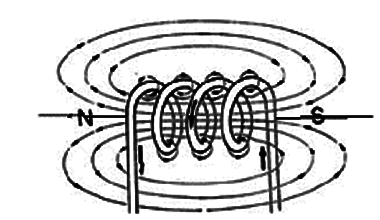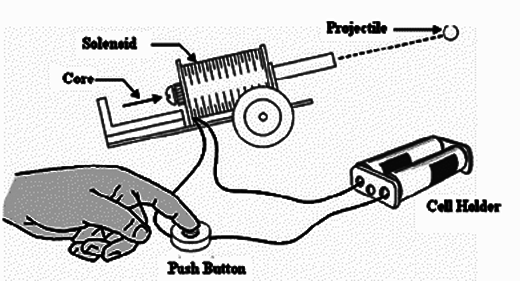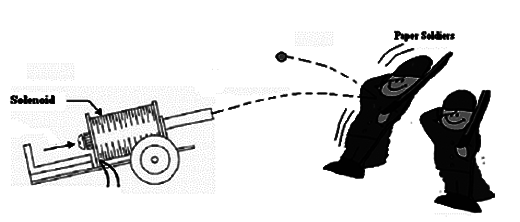A solenoid is a cylindrical coreless coil. When an electric current passes through a solenoid, a strong magnetic field is created inside it. Any metallic object placed near the coil will be attracted by the field as shown in figure 1.

A small solenoid that attracts small objects can be easily built using common materials. A cannon capable of launching a bullet a few dozen inches ahead is an interesting project using the solenoid.
4 C or D cells with holder
1 cardboard tube - size 0,8 cm of diameter and 5 to 6 cm of length
20 m or more of enameled wire 28 AGM or thinner
1 2” x 1/4’ screw as core for the cannon
1 push button (NO)
Beans or other objects for the projectile
Building and Testing the Solenoid
Wind the enameled wire in the tube, taking the time to carefully remove the enamel cover at the points were it connects with the battery (4 cells). Assemble the solenoid as shown by figure 2 using a small screw as core. The screw must slide free inside the core of the solenoid. As projectile, you can use small objects (not metallic) like beans.

The current across of the circuit is high. So, don’t keep the push button pressed after the trigger. Press during a very short time interval, only enough to pull the core inside the solenoid. If you keep the push button pressed, the battery will run down in a short time.
Explaining the Project
Use drawings to show how are the force lines of the filed of a solenoid and compare them with the field created by a permanent magnet. Combine it to ART230E —The Oersted’s Experiment to explain why the magnetic field of a solenoid is stronger inside the core. Explain why metallic cores are attracted by the solenoid. Explain why the force and the range of the small cannon depend on the number of the turns of the coil and on the current supplied by the cell.
Additional Experiments
Place small nails, pins and paper clips near the solenoid and pressing the push button show that they are attracted by the core of the solenoid. Show that only metallic objects are attracted by the solenoid. Repeat the experiment using a permanent magnet.
Show that the solenoid has poles like a magnet and that like poles create a repulsion force. You can use a power supply to power the cannon. Supplies sourcing up to 2 A can be used, but don’t keep the push button pressed for more than one second. Only a light touch to pull the core and launch the projectile! High currents during long periods of time can overload the supply and burn the coil. A solenoid can also be used to push or pull objects.
Competition:
Two kinds of competitions or challenges can be programmed with the cannon. You can test the skill of the pupils by verifying who built the most powerful cannon. The test consists in seeing who can reach the largest distance when launching the projectile.
Another competition is a simulated war. Each army has is own cannon and paper soldiers as shown by figure 3. The winner is the one who can knock all enemies down using only the cannon.

Questions:
1. Explain why the force lines of a magnetic field are closed lines.
2. Indicate the factors that determine the strength of a solenoid field.
3. Why only ferrous materials are attracted by the solenoid and other metals such as aluminum, zinc and copper are not?
4. Why does the coil heat if the current is kept circulating through it for long time intervals?



